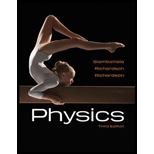
(a)
The momentum magnitude of the original particle.
(a)
Answer to Problem 87P
The momentum magnitude of the original particle is
Explanation of Solution
Write the expression for the magnitude of momentum for each particle.
Here,
Write the expression for Lorentz factor.
Here,
Multiply denominator and numerator of equation (I) by
In problem it is given that the particles are moving at right angle to each other.
Calculate the vector sum of their momenta.
Write the expression for the rest mass energy of the particles.
Here,
Substitute
Substitute
Conclusion:
Substitute
According to momentum conservation principle, momentum of original particle is equal to vector sum of the momenta of the pions.
Therefore, the momentum magnitude of the original particle is
(b)
The kinetic energy of the original particle.
(b)
Answer to Problem 87P
The kinetic energy of the original particle is
Explanation of Solution
According to conservation of energy, total energy of the original particle must equal to the sum of the total energy of two pions.
Write the expression for the total energy pions.
Here,
Write the expression for the total energy of first pion.
Write the expression for the total energy of second pion.
Substitute
Write the expression for the total energy of original particle.
Here,
Rearrange above equation to get
Write the expression for the kinetic energy of original particle.
Here,
Conclusion:
Substitute
According to conservation of energy,
Substitute
Substitute
Therefore, the kinetic energy of the original particle is
(c)
The mass of original particle in units of
(c)
Answer to Problem 87P
The mass of original particle in units of
Explanation of Solution
Write the expression for the rest mass of the particle in terms of rest energy.
Conclusion:
Substitute
Therefore, the mass of original particle in units of
Want to see more full solutions like this?
Chapter 26 Solutions
Physics - With Connect Access
 College PhysicsPhysicsISBN:9781305952300Author:Raymond A. Serway, Chris VuillePublisher:Cengage Learning
College PhysicsPhysicsISBN:9781305952300Author:Raymond A. Serway, Chris VuillePublisher:Cengage Learning University Physics (14th Edition)PhysicsISBN:9780133969290Author:Hugh D. Young, Roger A. FreedmanPublisher:PEARSON
University Physics (14th Edition)PhysicsISBN:9780133969290Author:Hugh D. Young, Roger A. FreedmanPublisher:PEARSON Introduction To Quantum MechanicsPhysicsISBN:9781107189638Author:Griffiths, David J., Schroeter, Darrell F.Publisher:Cambridge University Press
Introduction To Quantum MechanicsPhysicsISBN:9781107189638Author:Griffiths, David J., Schroeter, Darrell F.Publisher:Cambridge University Press Physics for Scientists and EngineersPhysicsISBN:9781337553278Author:Raymond A. Serway, John W. JewettPublisher:Cengage Learning
Physics for Scientists and EngineersPhysicsISBN:9781337553278Author:Raymond A. Serway, John W. JewettPublisher:Cengage Learning Lecture- Tutorials for Introductory AstronomyPhysicsISBN:9780321820464Author:Edward E. Prather, Tim P. Slater, Jeff P. Adams, Gina BrissendenPublisher:Addison-Wesley
Lecture- Tutorials for Introductory AstronomyPhysicsISBN:9780321820464Author:Edward E. Prather, Tim P. Slater, Jeff P. Adams, Gina BrissendenPublisher:Addison-Wesley College Physics: A Strategic Approach (4th Editio...PhysicsISBN:9780134609034Author:Randall D. Knight (Professor Emeritus), Brian Jones, Stuart FieldPublisher:PEARSON
College Physics: A Strategic Approach (4th Editio...PhysicsISBN:9780134609034Author:Randall D. Knight (Professor Emeritus), Brian Jones, Stuart FieldPublisher:PEARSON





